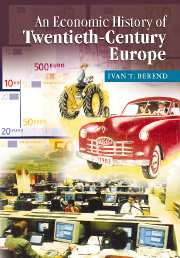 An Economic History of Twentieth-Century Europe
An Economic History of Twentieth-Century Europe Book contents
- Frontmatter
- Contents
- List of boxes
- List of figures
- List of tables
- Acknowledgments
- Introduction
- 1 Europe's laissez-faire system and its impact before World War I
- 2 Decline of laissez-faire and the rise of the regulated market system
- 3 Economic dirigisme in authoritarian–fascist regimes
- 4 The centrally planned economic system
- 5 Mixed economy and welfare state in an integrated post-World War II Western Europe
- 6 Globalization: return to laissez-faire?
- Bibliography
- Index
5 - Mixed economy and welfare state in an integrated post-World War II Western Europe
Published online by Cambridge University Press: 05 June 2012
- Frontmatter
- Contents
- List of boxes
- List of figures
- List of tables
- Acknowledgments
- Introduction
- 1 Europe's laissez-faire system and its impact before World War I
- 2 Decline of laissez-faire and the rise of the regulated market system
- 3 Economic dirigisme in authoritarian–fascist regimes
- 4 The centrally planned economic system
- 5 Mixed economy and welfare state in an integrated post-World War II Western Europe
- 6 Globalization: return to laissez-faire?
- Bibliography
- Index
Summary
After World War II a new, consistent economic system emerged in Western Europe. Although most of the elements of the new regime had already been “invented” and applied in one of the previously introduced economic systems, they were realized in a new combination and accomplished with various important new elements that, at last, resulted in a new economic system.
One of the most characteristic elements of the postwar Western regime was state interventionism. It was not new at all, having been a feature of the regulated market economy of the interwar decades. It became, however, more complex: besides counter-cyclical measures, subsidies, foreign trade and monetary regulations, it led to the foundation of a strong state sector of the economy, often combined with planning.
The mixed, mostly private, partly state-owned economy was not a novelty either. Economic dirigisme operated a peacetime mixed economy in interwar Italy and Spain. Postwar mixed economies, though in different ways and scope, also used state planning. This method, again, was already familiar in the interwar Soviet non-market system, and, in some way, in countries of economic dirigisme. After World War II, nevertheless, state- owned companies followed the targets of state planning and worked in an undisturbed market economy. Planning was not forced upon them but served competitiveness and the introduction of new high-technology sectors.
The most peculiar novelty of the postwar West European economic regime was the integration of all these elements of state intervention into a free trade system.
- Type
- Chapter
- Information
- An Economic History of Twentieth-Century EuropeEconomic Regimes from Laissez-Faire to Globalization, pp. 190 - 262Publisher: Cambridge University PressPrint publication year: 2006


